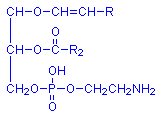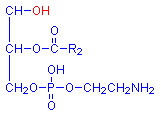A less commonly used procedure employing Schiff’s reagent is the plasmal reaction. This technique demonstrates plasmalogens. These are acetal phosphatides, lipids which can be hydrolyzed by mercuric chloride to produce aldehydes. They are a common component of myelin. Some acetal phosphatides can resist paraffin processing and can be seen in paraffin sections.
Chemical Reaction

Plasmalogen
+ HgCl2 + H2O =

Alcohol
+

Aldehyde
+ HCl
Considerations
A difficulty with this procedure is that aldehydes can be produced in some lipids during fixation in formalin. Lipids which color red with the Schiff’s reagent because of this are termed pseudoplasmals. Due to this effect of formalin fixation, true plasmalogens (acetal phosphatides) must be demonstrated in frozen sections of unfixed tissue, or tissue which has been treated with formalin for less than 6 hours. A control with an aldehyde block should always be used.
A second problem is that hydrolysis in acids, including the hydrochloric acid in Schiff’s reagent itself, can also hydrolyze plasmalogens. This may lead to difficulties in interpretation, as it may cause a false positive reaction in a section that has not been treated with the mercuric chloride. An untreated section should be negative for the plasmal reaction to be considered reliable.
In practice the plasmal reaction is not in common use. It’s significance lies more in the possibility that some materials may be colored in reactions using Schiff’s reagent that may be misidentified. If there is any likelihood of this, then appropriate controls should always be used to ensure that these lipids do not stain. In the vast majority of cases this would not be a concern.
References
- Pearse, A. G. E., (1968, 1972)
Histochemistry: Theoretical and Applied, Ed. 3
Churchill Livingstone, Edinburgh, London, UK - Kiernan. J.A., (1999)
Histological and histochemical methods: Theory and practice, Ed. 3
Butterworth Heinemann, Oxford, UK.
Citing:–
Terner, J. Y., and Hayes, E. R., (1961)
Histochemistry of plasmalogens
Stain Technology, v. 36, p. 265






